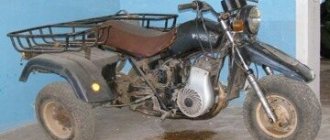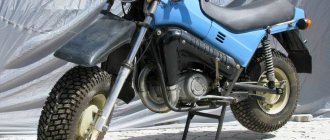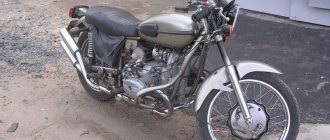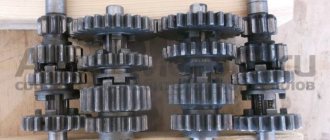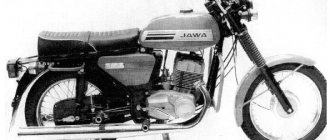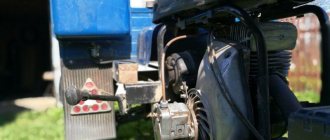Despite quite active attempts by several enterprises to establish the production and sale of scooters in the USSR, this type of equipment had difficulty taking root in our country. One of the reasons for the cool attitude of citizens towards scooters was the poor quality of roads, which did not allow all the advantages of the concept to be realized. Therefore, a new Tula motorcycle was released.
The specialists of the Tula Machine-Building Plant were aware of this problem. In 1984, a new project was implemented and the TMZ-5.951 Tula off-road motorcycle went into production. Contrary to popular belief, this model was never called Tula 200.
Specific approach
The concept of the car was quite interesting. A robust duplex frame, long-stroke suspension shock absorbers, an engine equipped with a forced air cooling system, tires designed for off-road driving...
All this seemed to make Tula's motorcycle very promising. However, the fate of this technology cannot be called successful. Why? Let's try to figure out the reasons. And to better understand them, let's start with the basic parameters.
Review
The Tula SUV was an innovation among Soviet motorcycles; for the first time the engine was started by an electric starter and air cooling was used. The motorcycle was equipped with a 200 cc gasoline engine, special wheels and a suspension system. The motorcycle had many positive reviews.
| pros | Minuses |
| + easy to maintain, + reliable, + low fuel consumption, + will drive on any road. | - low speed, - heaviness, - dirt and water can get into the wiring. |
Main characteristics
Let's be honest, when evaluating a Tula motorcycle, characteristics are not decisive. But since many people pay their attention to them first of all, we will not break traditions. Brief technical specifications are as follows:
- The engine is a two-stroke, single-cylinder, equipped with a forced cooling system. With a volume of 200 cubic meters. see it develops a power of 12.5 liters. With. on TMZ-5.951, and 13 l. With. in the later modification TMZ-5.952. Oil had to be poured directly into the fuel.
- Starting system - starter-generator.
- The main fuel is A-76 gasoline.
- MS-20 oil was added in a proportion of 25 grams per 1 liter of fuel.
- The gearbox is foot-switched and has 4 stages.
- Maximum speed – 85 – 90 km/h, depending on the modification.
- Fuel consumption (average) – 3.6 liters per 100 km.
- Weight (dry) – 129 kg for early and 126 kg for later modifications.
The car had a chain drive on the rear wheel, a front telescopic fork and a rear pendulum suspension. And then... Then problems began that could not be completely resolved.
MY MOTORCYCLE
The 60s became the golden era of our motorcycle industry. The factories entered stable mass production, the range expanded, models were modernized every two to three years, but they had not yet lost their development potential and were not left behind “forever.” And most importantly, the designers created completely new cars. Such as the Tula motor scooter "Tourist".
Although the T-200 and T-200M passenger scooters had gained a certain popularity by the mid-60s, a lot of complaints had accumulated against them, both from buyers and manufacturers. The first ones were not satisfied with the dynamics: 9 hp. by 150 kg - not at all impressive even by the standards of those times (with a similar mass, the Izh-Planet had a 13-horsepower engine). The handling was also not ideal, even after switching to a new front fork. And the heavy Teutonic design looked completely archaic (its ancestor - the Goggo TA200 scooter - was retired by Hans Glas back in 1957).
Manufacturers did not like the design of the chassis at all, with an openwork spatial frame under a complex hood. At the end of the 50s, the labor intensity of manufacturing the T-200 was three times higher than the M-72! And although this situation improved with the growth of production, the car had to be sold almost at cost.
A potential replacement for the T-200 was developed back in 1959 - just a couple of years after the start of mass production - by designers Anatoly Dmitrievich Kozin and Emilia Fedorovna Pozdnyakova. In the T-200-M3 “Meteor” scooter they used elements of electrical equipment from “Vyatka”. The front shield and rotary wing were also modeled after this vehicle. Refusal of the dynastarter and battery, lighter cladding made it possible to reduce the weight to 130 kg! In the engine of this prototype, the designers replaced the chain motor transmission with a gear one. But it remained a prototype - the refusal of electric start fundamentally killed the very idea of a “luxury scooter”.
Tulsky's first experiment.
At the same time, Tula became concerned with designing a new engine. The new development was headed by Yuri Petrovich Pozdnyakov, who laid down many progressive solutions: an aluminum cylinder with a cast iron liner, a combustion chamber with a vortex effect, and a gear motor transmission. And most importantly, he radically increased the engine displacement to 247 cm³, using a “square” dimension (68.0 × 68.0 mm).
And the new chassis was proposed by the young gunsmith designer Evgeniy Nikolaevich Shcherbakov, who in May 1960 moved to work in the department of the chief designer from the secret TsKB-14. An avid motorcyclist (like a quarter of the entire male population of the USSR in those years), in his project he combined all the latest achievements of technical thought (and in some ways he was ahead of his time): an engine in a block with a rear suspension pendulum, an automatic V-belt variator, a front long-link fork , pneumatic-hydraulic shock absorbers with adjustment by pumping, 14-inch wheels, plastic cladding and internal luggage racks.
Despite the youth of the designer, the project was taken very seriously and was discussed at a meeting with chief engineer Lev Sergeevich Mochalin. And then experienced production workers said: the development is interesting and promising, but unrealistic. Firstly, it is completely devoid of unification with the manufactured vehicle. Secondly, it is not easy to make a cargo modification based on it. Thirdly, where can you find specialists in automatic transmissions and hydropneumatic shock absorbers? The Serpukhov TsKEB could no longer help: at that time another Khrushchev experiment happened - economic councils. They decided to restructure the entire industry from a sectoral to a territorial principle. As a result, TsKEB was inundated with orders such as designing an automatic machine for the production of nails for a local factory.
Therefore, the young designer was offered to develop a machine for the new T-250 engine and with an eye to unification with the produced T-200. And he began by working out the general layout and appearance: the plasticine model was ready at the end of 1960. Moreover, Shcherbakov did it himself: there was no such position as a designer at the plant at that time. The result is a kind of collective image of a large scooter of those times: it shows features of the BSA Sunbeam, Hercules R200, TWN Contessa, and even the experimental BMW R10 (which, by the way, it is most similar to - although the Tula residents certainly could not see it : BMW declassified the development only in the 70s). Evgeniy Nikolaevich himself claims that he was inspired by the shapes of... the legendary Volga GAZ-21.
In the layout, the main innovation was not even the load-bearing hood, which made it possible to abandon the complex spatial frame, but the “inverted” engine: intake from the front, exhaust from the rear. The carburetor and air filter were located in the tunnel between the driver's legs, the air intake was in the front fender, in the cleanest area. The muffler zigzagged to make room for an internal trunk at the rear of the car.
The prototype is the Dolphin scooter. The chrome grille on the front fender hides the air intake.
The first copy of the new scooter, named "Dolphin", was assembled at the end of 1961 - with the old T-200 engine. But full-fledged tests began only in 1963, when ready-made samples of the T-250 engine arrived. I immediately liked the car - both for its dynamics and comfort (the Dolphin's suspension travel was twice that of the T-200). By the way, the first samples of the T-250 developed a modest 11 hp. But especially for the championship of the factory brand, the T-250S sports scooter was developed with boost to 14 hp. engine, reduced weight due to the refusal of electric start and a high steering wheel, the levers on which were even equipped with safety balls. The same 14 hp. soon became an indicator for the “serial” T-250, and on some samples it was possible to obtain 16 and even 18 hp.
“Reverse” layout of the “Dolphin” - inlet at the front, exhaust at the rear.
Meanwhile, “Dolphin” had an alternative named “Humpbacked Horse”. Its author was a very extraordinary designer - Vitaly Pavlovich Plotnikov. And the design he created did not resemble anything at all. The basis of the chassis was a powerful spinal frame made of a pipe with a diameter of 80 mm. A horizontal 350 cc two-stroke engine was suspended from it, interlocked with a four-speed gearbox. The launch was carried out by a pneumatic starter, and the frame itself was used as a receiver (the stored compressed air was enough for several starts). A pneumatic compressor driven by an eccentric on the gearbox shaft was built into the crankcase of the power unit. The front fork is telescopic, the rear fork has a cast aluminum pendulum mounted on the crankcase of the power unit coaxially with the main drive sprocket, and a horizontal monoshock absorber. The lining with a built-in 35-liter gas tank is made of fiberglass.
Soviet-era concept scooter - “Humpbacked Horse”.
The first copy of the “Humpbacked Horse” was built in 1965 and created a stir on Tula roads. Stories were passed from mouth to mouth about a miracle scooter that jokingly beats both the Volga and the Java. Of course: after all, with a dry weight of 129 kg, the engine of the experimental car produced 32.5 hp. But Vitaly Pavlovich got a taste for it, and unusual proposals came one after another: cast wheels (remember: there were ten years left before their mass use abroad!), air suspension, an air braking system with ABS. Not everything was realized in metal, but the cast wheels were made and even tested in a very harsh way: since skeptics (which included all the factory management) were afraid that the wheels would split from the slightest impact, Plotnikov threw them from the roof of a multi-story workshop - without dangerous consequences.
Dense arrangement of the Little Humpbacked Horse units.
But The Little Humpbacked Horse was too revolutionary and too detached from production possibilities. As they would say today - a concept scooter. And in 1964, the plant management decided to prepare “Dolphin” for launch into series. In fact, this resulted in the reconstruction of the entire motorcycle production, and for the production of a 250 cc engine in a limited factory area (after all, TMZ is located in the very center of a large city), they managed to find a place for a new workshop. To conduct large-scale tests, a pilot batch of 50 vehicles was produced.
And then thunder struck! The plant received an urgent task in its main specialization: to master the production of a turret for the Shilka anti-aircraft complex. The areas intended for the T-250 engine were allocated for its production. And then the management of the enterprise makes a compromise decision: to continue preparing the production of a new scooter, but with a modernized T-200 engine. The hybrid received the index T-250/200 and a new name: “Tourist” (they say the minister did not like the previous name: What “Dolphin”? Where are you - and where is the sea?).
“Tourist” went into production with the old 200 cc engine.
So, what was the “Tourist” - the model that became the basis for all Tula scooters until the end of their production? The 200 cc engine was boosted from 9 to 10 hp by using a “jockey cap” combustion chamber, which ensured better mixing of the mixture. The new frame, made from larger cross-section pipes, not only had twice the rigidity, but also lowered the machine's center of gravity. The load-bearing hood made it possible to abandon both the complex rear subframe and removable panels: to access the engine, the hood folded back, and the spark plug and gas tank cap could be reached through the folded seat. The front long-link fork and rear pendulum suspension received twin-tube shock absorbers. The stamped wheels, while maintaining the 10-inch size, became unified, and the diameter of the brake drums increased. An innovation was the installation of direction indicators. The ignition switch was unified with the unit from Moskvich-408.
Over the course of five years, the Tula Machine-Building Plant developed four different machines. If only mass production could maintain such a pace!
The Tula residents tried to coincide with the start of serial production of “Tourist” to coincide with the anniversary - the 50th anniversary of the October Revolution. But in 1967, only 300 cars were made, after which their production had to be suspended. The fact is that on prototypes the aluminum alloy steering wheel was made by casting into the ground, and on production cars by casting into a chill mold, which initially led to an increase in porosity. Only in 1968, when this problem was solved, did the Tourist completely replace the T-200 on the assembly line.
The hinged hood provided access to the scooter components. It was locked with a simple padlock, which was unlocked by protrusions on the head of the ignition key.
Cast "Tourist" steering wheel with built-in speedometer.
I could not have changed it alone... Simultaneously with the production of “Tourist”, V. Mosin and I. Lerman developed another alternative option - “Start”. This scooter had more modern straightened fascias and a headlight built into the front fender (no doubt inspired by the popular Ceseta). The designers tested several versions of the “Start” - both completely identical to the “Tourist” in terms of chassis, and with modifications. The option of producing two models on one platform was seriously considered: “Tourist” for conservatives and “Start” for innovators. Alas, economists nipped the idea in the bud.
An alternative option is the “Start” scooter.
But economists voted with all their might for the cargo option. It went into production in 1969. The front part is from the “Tourist”, the rear part is from the TG-200, which was thoroughly modernized in 1963, but with full hydraulic shock absorbers instead of the previous rubber buffers. The new truck received the index TGA-200 and its own name “Ant” - so successful that many considered it not a factory designation, but a popular nickname.
The cargo version is the TGA-200 Ant scooter.
Layout of the "Tourist" scooter.
Issue: MOTO Magazine – December 2015
Author: Alexander VORONTSOV, photo by Evgeny BOBRIKOV and from the archives of the author and Leonid Pavlovich ZYAKIN
website moto-magazine.ru
A bunch of problems
Yes, Tula’s motorcycle really moved well off-road. With the proper skill of the rider, he could even move across a plowed field. But on smooth asphalt the car felt uncomfortable. The relatively low speed and specific parameters of the engine, the main parts of which were borrowed from the unit used on the Tula 200 scooter, also had an effect.
Wide tires, which successfully cope with mud, began to slip on wet asphalt, which affected operational safety. The asymmetrical design of the motor led to a shift in the center of gravity to one side. This also did not improve handling in corners.
There wasn't enough speed. On the track, the Tula motorcycle could overtake a moped, but was seriously inferior in dynamics to traditional road motorcycles. I was also not pleased with the high fuel consumption for cars of this class. On the cars of the first series, a fuel tank was installed, consisting of two halves that did not communicate with each other. This turned out to be extremely inconvenient and was subsequently eliminated by installing a single tank.
A special concern for those who operated a Tula motorcycle was the starter-generator (dyno starter). It often broke down, providing neither reliable starting nor a normal level of battery charge. In addition, the domestic industry at that time did not produce compact twelve-volt batteries capable of generating high starting current.
At first, the car had to be equipped with two batteries, which added significant weight. The battery for the Tula motorcycle, made in a single format, appeared only on the later model. So for those who purchased the Tula motorcycle, the technical characteristics were in the background...
Disadvantages of the model
Nowadays you rarely see this model of bike on the roads. But he did not completely disappear from our roads. You can also find and buy a “Tula” motorcycle if you wish. His photo, however, will not always fully correspond to the original design. Over the years, most models have undergone a number of changes.
The decrease in demand is based on a number of shortcomings that are characteristic of this type of vehicle. Among them are the following:
- Low maximum speed.
- Heavy weight, which affects off-road driving.
- Due to the large width of the wheels, the motorcycle tends to “bump” when cornering. On wet road surfaces, the wheels lose stability.
- The installed starter required a higher starting power from the battery. Therefore, two of them were installed on the first models. In the USSR at that time there simply were no batteries with a small size and high current. For the later version, only one battery was left.
Despite its shortcomings, the Tula motorcycle takes its place in the history of technology development in Soviet times.
The Unfinished Story
Despite these shortcomings, residents of the outback showed a certain interest in this specific technique. Due to the specific design of the equipment, tuning has become a favorite pastime of many owners. This gave TMZ specialists a reason to develop several additional modifications, among which was even the Tula TMZ-5.971 tricycle, produced in a small series.
It was assumed that the three-wheeled model would become an alternative to the popular TGA 200 Ant scooter. It is not known exactly how many of these machines were produced. The collapse of the USSR and the resulting problems in the economy could not but affect the work of TMZ.
In an effort to survive, enterprises of the defense complex, which included the Tula Machine-Building Plant, sometimes even took risky steps. Another attempt was made to improve the Tula motorcycle and promote the model to the European market.
But it soon became clear that, according to EEC standards, a bike with a center of gravity so significantly shifted to the side cannot be allowed for use. The idea is dead. The model was finally discontinued in 1996.
Three versions
- TMZ-5.951. It was produced for 6 years, starting in 1984. It weighed 129 kilograms. It could reach a speed of no more than 85 kilometers per hour. The engine had a power of 12.5 horsepower.
- TMZ-5.952. It was also developed and produced for 6 years, since 1990. Equipping with a lighter frame made it possible to reduce the total weight by 3 kg. The engine has become more powerful, although only half the horsepower has increased. Speed performance increased - now it was possible to accelerate to 90 kilometers per hour.
- TM3-5.971. It was assembled and produced at the same time as the previous version and was actually its redesigned version with the TMZ-9.906 cargo module. The frame has been strengthened. However, neither the engine nor the steering wheel with the front fork have undergone any changes. The model was a three-wheeled motorcycle with a trunk weighing 129 kg (without a passenger). It was also provided for attaching a trailer for 1 quintal of cargo. The connecting nodes were hidden under a plastic lining.
Name confusion
As for the mistake with the name Tula 200, that’s a different story. This was the name of the scooter, the production of which was organized at TMZ in 1956. The model almost completely copied the German scooter Glas Goggo TA55. The car turned out to be quite successful. Tula 200 served as the basis for the following modifications, such as Tourist and Tulitsa.
Almost simultaneously with the Tourist scooter, the TGA 200, created on the same units, appeared. The basis for the design of the power units of all of the listed modifications was the T-200 engine, which appeared in 1956. Supplemented with an air cooling system and modified, the engine was also used on the Tula motorcycle. Apparently, this was the reason that some, out of habit, began to call the bike Tula 200.
Frame and wheels
The Tula motorcycle (photo can be seen in this article) is built on a duplex frame, the quality of which is quite acceptable. It has a high torsional rigidity. Thanks to this, the developers were able to achieve improved handling.
As mentioned above, the motorcycle is equipped with small wheels with wide profile tires, more suitable for scooters. Due to the small diameter, the center of mass has decreased and road grip has improved. This has led to improved sustainability. The increased width of the wheels made it possible to reduce pressure on the ground and thereby increase cross-country ability.
Note for connoisseurs
If you liked this story and are partial to the history of domestic technology, then a lot of useful information awaits you on our website. Here you can find out what is good about the Ant scooter and what advantages the Izh Jupiter-5 motorcycle has, and much more interesting things...
Previous entry Technical characteristics of the Izh Planet-3 motorcycle
Next entry Composition and parameters of electrical equipment IZ Jupiter 5
Price
Since the production of Tula motorcycles has been discontinued, it is impossible to purchase a new copy. In the advertisements there are offers of almost new motorcycles with a mileage of 100-150 kilometers, which have simply been sitting in garages for a long time. Prices for motorcycles vary depending on their condition and tuning, but there is a certain range and ranges from 15 to 50 thousand rubles.
Note for connoisseurs
If you liked this story and you are not indifferent to the history of domestic cars, then on our website you will find a lot of useful information. Here you can find out what a good Muravy scooter is and what advantages the Izh Jupiter-5 motorcycle has, and much more. You can also add a comment to this article, or share it on social networks. We will be happy to respond to your feedback.
Test menu:
- Go to Main page
- about the project
- Groups and categories
- Privacy Policy
- Latest posts by the author - links to content
- See car ratings
- Contacts
- Site Map
Specifications
| Maximum engine power: | 12.5 - 13 HP |
| Working volume: | 200 cm3 |
| Motor type (cylinder arrangement, number of strokes): | 1-cylinder, 2-stroke |
| Number of cylinders: | 1 |
| Number of valves: | |
| Intake type (Injector / Carburetor): | |
| Bore and stroke: | |
| Starting system (Electric starter, kick starter): | |
| Maximum speed in km/h: | 85-90 km/h |
| Cooling system: | Air |
| Transmission (gearbox): | Mechanical 4-speed |
| Clutch (Dry / Wet): | |
| Drive unit: | Chain |
| Frame: | Steel |
| Chassis | |
| Suspension (front/rear travel): | |
| Brakes (Front/Rear): | |
| Wheels / Tires / Rubber: | |
| Dimensions and weight | |
| Dimensions (Length / Width): | |
| Seat height: | |
| Ground clearance: | |
| Curb weight: | |
| Weight: | 126 - 129 kg |
| Fuel tank capacity: | 12 l. |
| Battery capacity: | |
| Year of release: | |
| Country of Origin: |
Farm equipment manufacturer's failed attempt to build motorcycles
The fact is that the manufacturing company specialized in agricultural machinery and assembled scooters from ready-made parts, which in any case were purchased separately. Such designs allowed production to become more flexible.
The German company began producing Goggo scooters in 1951 and within five years produced over forty-six thousand devices. However, it could not realize itself as a motorcycle manufacturer due to the specialization of agricultural machinery. But Tula designers took advantage of the designs for prefabricated scooters and created first a cargo scooter, and then a “Tula” motorcycle. This happened in the early seventies.
Tula is ahead of the rest!
In the first small hall of the only Tula motorcycle museum, we were greeted by just one motorcycle against the backdrop of a painted wall with clearly visible Tula views...
“This hall is not yet fully completed,” noted Leonid Pavlovich. — It is dedicated to the first Soviet motorcycles of the pre-war period. One is ready for now - L-300. It was produced from 1930 to 1938.
In total, about 19 thousand pieces were produced, but about 40 around the world have survived to this day.
And in such good condition - no more than a dozen! I collected it for four years, starting literally with a pile of rusty iron. Next to him very soon there will be another “veteran” - IZH-7. Now it is under restoration, I hope we will have time to finish it by the end of the year. In general, assembling motorcycles is a very lengthy, complex and expensive issue. All the parts are assembled bit by bit, often taking years to complete one car.
The owner of the museum also spoke about the painting on the wall:
- Here is a view of Comintern Street, the former Pavshinskaya - a church, old houses and a view of the Machine Plant. It was drawn from old photographs taken from the archive. By the way, it is no coincidence that the Mashzavod workshops are here: after all, scooters were once assembled there!
In addition, there are old photos hanging on the walls of this room. On them you can see the world's first motorcycle, produced in 1885, the first motorcycle of the then Russian Empire, produced in 1910, and the first Soviet motorcycle, born in 1923-1924.
Leonid Pavlovich told an interesting story about another photo.
— 1929 was the starting year for the domestic motorcycle industry. Then a test run of 3 thousand km of Soviet designs and foreign motorcycles was carried out to identify a model that could be put into production. Moreover, motorcycles of such brands as Indian, Harley-Davidson, BMW took part in this race. And the development of the Tula mechanic Tokarev, made practically from scrap materials using a foreign engine, competed with them. So, he made it to the end, but the guests from abroad did not! They were not designed for our off-road conditions.
How it all began?
At that time, in the fifties of the last century, the USSR and Japan literally took off in the development of motor vehicles. Before the war, both in one and in another country, very small numbers of them were produced, which, in comparison with foreign models, looked very outdated.
But after the war, equipment was delivered from Germany that became the basis for the domestic motorcycle industry. Since 1956, during the “thaw”, Goggo TA200 of German origin began to be produced in Tula. But some components in it were replaced with domestic ones. So the Tula German began to be assembled from purchased units.
Switching to wide-profile tires
But outside the Soviet Union, motorcycle culture flourished and many fell in love with motorcycles as sports equipment and a form of active recreation. As a result, manufacturers began to produce a large number of small-capacity models for people who had no driving experience. One of these models was the Japanese Suzuki RM.
Tulsk residents, as soon as the opportunity arose, bought such a motorcycle to get acquainted with it.
As a result, they decided to put their “Cheburashka” on wide-profile tires. Designer Evgeniy Dmitrievich Vlasov, who was the driving force behind the Tula motor vehicle, managed to promote the idea of its production in the ministry. Then the Izhevsk, Kovrov and Tula factories were instructed to create motorcycles on a competitive basis. Since the Tula plant already had experimental motor vehicles, he won the competition. Then a production batch came out with identical wheels in front and behind.
Garage as a meeting place
The next room turned out to be dedicated not to motorcycles, but to an entire era... The era of garage recreation!
“In the 60s of the last century, it was impossible to imagine a man without a garage,” Leonid Pavlovich says nostalgically. “It was a whole kind of relaxation.” Here you could tinker with technology, plan, saw, do something... Drink 100 grams with your neighbor friends. Yes, and the woman who had the sofa could be brought in!
Now, unfortunately, this is not at all relevant... Cars are parked either in courtyards or in parking lots, and the garage is taking a rest. So I decided to dedicate a separate room to him. At first there was just a motorcycle and tools. And then the visitors themselves began to bring individual things: a Chaika vacuum cleaner, an accordion, a guitar from the Soviet period, a Tula samovar, a whole collection of cameras, a receiver, a primus... Even a real moonshine still!
"Cheburashki"
The engine of the motor vehicle was suspended on a backbone frame, which was open on all sides. Thus, forced cooling, which was on the German scooter with a fan, could be abandoned. The weight of the motor has decreased, which has made the position of the backbone frame easier.
Having made a number of changes, we managed to release a whole series of motor vehicles. They were significantly different from ordinary motorcycles and scooters and were very reminiscent of Gena’s favorite crocodile device from the well-known cartoon. Unfortunately, almost no funding was provided for them, so there were simply no prospects for widespread production at that time.
